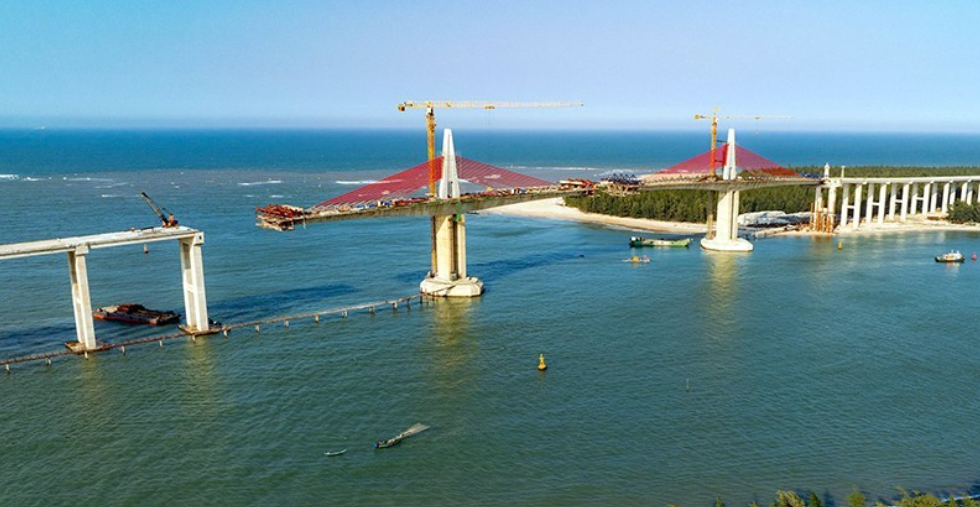 |
| The bridge crossing over Thuan An Estuary, part of the coastal road project passing through Hue City, is expected to be completed by April 30, 2025. (Photo: Dinh Hoang) |
In 2025, the total public investment capital approved and allocated by the National Assembly reaches nearly 830 trillion VND (over 32.2 billion USD), including over 353.6 trillion VND (over 13.7 billion USD) from the central budget and over 475.7 trillion VND (nearly 18.5 billion USD) from local budgets.
Accelerating disbursement
As usual, to accelerate public investment disbursement from the first day and first quarter, the prime minister issued Decision No. 523/QD-TTg on March 6, 2025, to establish task forces to inspect, urge, remove difficulties and obstacles, and promote the disbursement of public investment capital in ministries, sectors, and localities.
Accordingly, seven task forces will directly inspect the implementation of public investment tasks in certain ministries, sectors, and localities, carefully study the actual situation, clearly identify obstacles and bottlenecks at the grassroots level, as well as the competent authorities responsible for resolving them. They will then directly guide settlement of issues within the scope of their authority and legal regulations, ensuring quality, practicality, and efficiency.
The allocation and disbursement of public investment capital have been promptly focused on by the Government and relevant agencies. According to the Ministry of Finance, as of the end of February 2025, the prime minister had assigned investment plans totalling more than 825 trillion VND (over 32.02 billion USD) to ministries, sectors, and localities.
If taking into account the capital plan assigned by the prime minister, the increased local balanced capital plan and the rollover from previous years, the total investment capital plan assigned in 2025 will exceed 885 trillion VND (34.35 billion USD). Of this, more than VND 798 trillion, over 96% of the capital plan assigned by the prime minister, has already been allocated in detail by ministries, sectors, and localities.
Capital has been prioritised for national important projects, key projects, expressways, coastal roads, etc. As of February 19, 2025, more than 77.6 trillion VND (3.02 billlion USD) remained unallocated in detail, accounting for 9.42% of the plan assigned by the prime minister. The unallocated capital is concentrated in 24 out of 47 ministries and sectors and 49 out of 63 localities.
The delay in detailed capital allocation is due not only to projects awaiting adjustment and supplementation to the 2021–2025 medium-term public investment plan or new projects not yet eligible for capital allocation because of incomplete investment procedures but also to some localities having no demand for use, having requested to return funds, or having projects which are not yet approved for extended implementation.
According to the Ministry of Finance, the estimated disbursement of public investment capital in the first two months of 2025 was more than 60 trillion VND (2.3 billion USD), achieving 6.9% of the plan and 7.32% of the plan assigned by the prime minister (compared to 7.7% and 8.07% in the same period of 2024, respectively).
Recognising the difficulties and challenges in implementing public investment tasks, the Ministry of Finance identified key issues, such as slow compensation and site clearance processes for project construction, and limited capacity of project management boards and investment officials, especially at district and commune levels.
In addition, project costs have increased due to unexpected surges in the prices of many construction materials compared to the bidding time. The supply of certain materials remains limite, such as road embankment soil and construction stone, especially for transport infrastructure projects in the Mekong Delta region.
According to Deputy Minister of Finance Tran Quoc Phuong, there are eight growth drivers for sectors and localities in 2025, with public investment continuing to play a crucial role. Therefore, moving forward, it is necessary to focus on administrative reforms, expedite investment procedures, and remove barriers for businesses and projects. This approach reinforces the understanding that public investment disbursement remains a top political priority across all levels and sectors.
Driver and foundation for growth
In Vietnam, public investment accounts for a significant portion of total investment and makes substantial contributions to overall investment and socio-economic growth. Through public investment, state budget capital has activated and mobilised investment resources from across society, promoting public-private partnerships in strategic infrastructure development. As a result, public investment has initially proven effective as a "priming" capital source that leads investment from other economic sectors.
In recent years, the government has identified public investment disbursement as one of the most important political tasks at all levels, contributing to economic growth and creating new development space. Based on this orientation, the concept of public investment’s leading role extends beyond infrastructure development to include "soft infrastructure", such as connectivity, human resources, and operating costs.
Statistical data shows that from the start of the current term, public investment planning and management have been implemented decisively and specifically. As a result, the progress of public investment disbursement has improved. From 2021–2024, public investment capital was allocated in greater volumes, and disbursement efforts were enhanced, achieving a disbursement rate of 95.7% in 2021, 91.42% in 2022, 93.12% in 2023, and 93.06% in 2024.
Dr Le Duy Binh, Managing Director of Economica Vietnam, stated that if 95% of the total public investment capital approved by the National Assembly is disbursed in 2025, it will represent a huge financial resource injected into the economy, as the amount of capital assigned is significantly higher than in 2024.
From the perspective of aggregate demand, public investment currently accounts for around 30% of Vietnam’s GDP structure and will continue to be a major growth driver in 2025. However, disbursement must be accelerated from the beginning of the year to increase the turnover of capital in the economy, improve the efficiency of public capital, and better contribute to growth goals.
Not only does it serve short-term goals, public investment can also become a long-term driver and foundation if oriented toward human capital development, the semiconductor industry, and renewable energy, which are key factors to meet the development needs of high-tech industries and the green economy.
According to economic expert Nguyen Dinh Cung, 2025 is the final year of the 2021–2025 medium-term public investment plan. Projects whose investment procedures have been completed will enter the final stretch, and upon completion, will contribute immediately to growth and open new development opportunities for localities and economic zones.
Therefore, public investment remains a key driver for achieving the 8% growth target in 2025 and setting the stage for double-digit growth in the years to come. The government should continue to focus on removing obstacles for key infrastructure projects and national important projects to accelerate capital disbursement, increase economic spillover effects, and generate more jobs for society.
Currently, the challenges and difficulties in public investment have been clearly identified and should be addressed from both a legal framework and practical implementation perspective.
With a significant increase in capital scale compared to previous years, the allocation and disbursement of public investment capital in 2025 is highly meaningful for economic growth. Although public investment still faces limitations and obstacles, in recent years, it has focused on large-scale projects and national key works with high spillover effects, thus helping to drive socio-economic development and enhance the competitiveness of the economy./.





















































